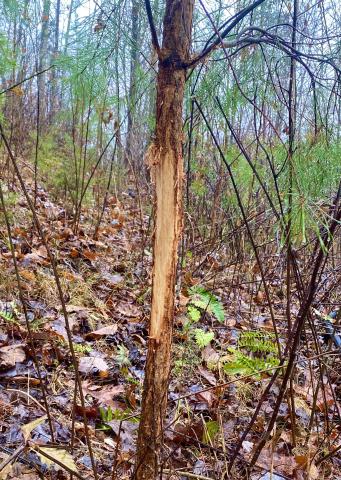Deer Sign: Clues to See the Unseen

Being observant while walking in the woods can make it more enjoyable. There are often signs of animal activity such as this deer rub.
By Steve Roark
Volunteer Cumberland Gap National Historical Park
White-tailed deer are widespread in our area and can be often seen along wooded edges or making a mad dash across the road. Even if you don’t see them, there are signs to look for when hiking in the woods that show their presence.
Tracks: Deer tracks show a cloven hoof with 2 long narrow toes around two inches long that are pointy at the top and rounded at the back. A print made in snow or deep mud may have 2 round marks behind the cloven hoof. These are from the dewclaws, which are two smaller toes farther up on the deer’s foot. When walking, deer place their hind feet in or near the prints of their forefeet, so the prints often overlap.
Scat: Deer droppings look like a pile of dark brown pellets each around ¾ inches long. During the spring and early summer, when deer are feeding on succulent vegetation, the pellets are softer and may stick together and form into large, soft droppings.
Trails: Deer often use regular routes through their home range that become worn-down trails, looking like narrow footpaths. They are usually clear of shrubs and low vegetation, but often not worn down to bare earth. Other animals often use the trails, including me, because they usually take the easiest routes through rough terrain.
Bedding: this will be a matted, flattened area of vegetation 3 to 4 feet long and 2 to 3 feet wide. Deer usually bed in areas of dense cover and may return to the same spot over several days. I have also seen bedding sign in hay fields near woodland edges. There may be several bedding areas in the same vicinity.
Rubs: these are bark scrapes on trees and shrubs made by a buck rubbing his antlers against the vegetation. Early rubs are made around September when the antlers have fully developed, and the buck rubs off the velvet that covers the antlers during their development. These early wounds may only tear a little bark. More conspicuous rubs show up in October, where large sections of bark are torn. These are territorial markings and meant to be seen. Scent markers are often placed on the tree at the time it is made by a scent gland located on the buck’s forehead. Research shows that bucks favor certain sizes and species of trees. One study showed that rub trees tended to be about 1 inch in diameter and 6 feet tall. Pine, cherry, red-cedar, and sumac appear to be favored species. They all have aromatic bark and perhaps give added scent to the rub mark. Other characteristics of rub trees include few lower branches and generally smooth barked. Each rub is used only once, and they tend to be clustered in a given area.
- Log in to post comments